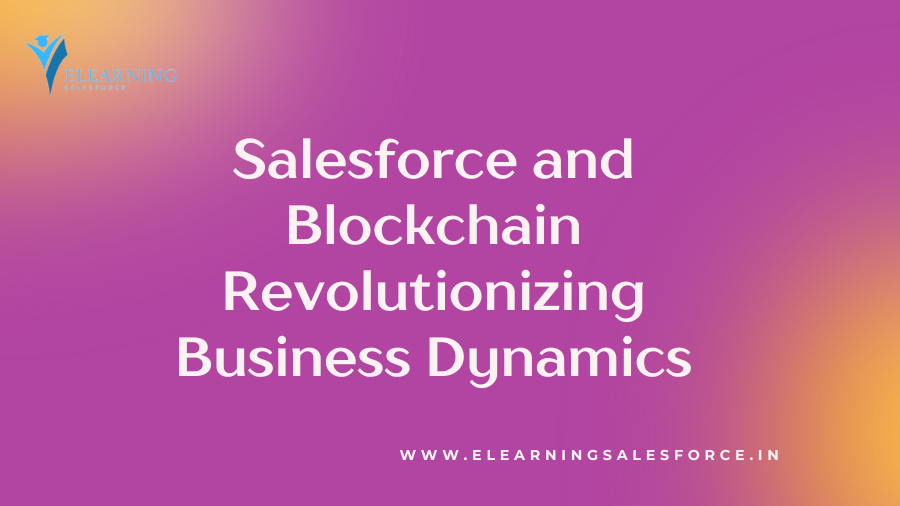In the ever-evolving realm of technology, two powerhouses, Salesforce and Blockchain, have joined forces to redefine how businesses operate and manage their data. This unique integration brings forth a synergy that goes beyond conventional systems, offering unparalleled benefits in terms of efficiency, security, and transparency.
I. Introduction
A. Overview of Salesforce and Blockchain
Salesforce, renowned for its customer relationship management (CRM) solutions, meets Blockchain, the decentralized ledger technology disrupting industries. The integration of these two technologies marks a pivotal moment in the tech landscape.
B. Importance of the Integration in the Business Landscape
As businesses grapple with increasing data complexities and the need for heightened security, the fusion of Salesforce and Blockchain emerges as a solution that not only addresses these concerns but also propels organizations into a new era of streamlined operations.
II. Understanding Salesforce and Blockchain
A. Explaining Salesforce
Salesforce, at its core, is a cloud-based CRM platform designed to enhance customer relations and streamline business processes. Its scalability and flexibility make it a go-to solution for a diverse range of industries.
B. Demystifying Blockchain
Blockchain, on the other hand, is a decentralized and distributed ledger technology. It ensures secure and transparent transactions by creating a chain of blocks, each containing a timestamped record of transactions.
C. The Synergy Between the Two Technologies
When combined, Salesforce and Blockchain create a robust ecosystem where data management becomes not just efficient but also secure. The decentralized nature of Blockchain complements Salesforce’s capabilities, providing an added layer of trust and transparency.
III. Use Cases and Benefits
A. Streamlining Data Management
The integration simplifies complex data structures, making information more accessible and actionable. Businesses can manage and analyze vast amounts of data seamlessly, leading to informed decision-making.
B. Enhancing Security and Transparency
Blockchain’s cryptographic principles ensure data security, reducing the risk of cyber threats. The transparent nature of Blockchain instills confidence among stakeholders by providing an immutable record of transactions.
C. Improving Customer Relations
Salesforce’s CRM functionalities, when coupled with Blockchain, enable businesses to build stronger customer relationships. The integrity and security of customer data contribute to a more personalized and trustworthy interaction.
IV. Integration Process
A. Steps to Integrate Salesforce with Blockchain
The integration process involves connecting Salesforce with a Blockchain network. This can be achieved through API connections and third-party solutions, with considerations for data mapping and compatibility.
B. Considerations for a Seamless Integration
A successful integration requires thorough planning. Businesses should consider factors such as data privacy, system compatibility, and user training to ensure a smooth transition.
C. Real-world Examples
Several businesses have successfully integrated Salesforce with Blockchain. Case studies illustrate the positive impact on data management, security, and overall operational efficiency.
V. Impact on Business Operations
A. Increased Efficiency
The streamlined data management and automation capabilities result in increased operational efficiency. Tasks that once required extensive manual effort can now be automated, freeing up valuable resources.
B. Cost Savings and Resource Optimization
Efficiency gains often translate into cost savings. By optimizing resources and improving processes, businesses can achieve a tangible return on investment, making the integration financially beneficial.
C. Gaining a Competitive Edge
In a competitive market, businesses that embrace innovative technologies gain a significant advantage. The Salesforce and Blockchain integration positions companies as tech-savvy and forward-thinking, attracting customers and investors alike.
VI. Addressing Concerns and Challenges
A. Data Privacy and Compliance
As businesses navigate the integration, ensuring compliance with data privacy regulations is paramount. This involves implementing robust security measures and adhering to industry-specific compliance standards.
B. Overcoming Resistance to Technological Change
The introduction of new technologies can face resistance from employees. Effective change management strategies, coupled with comprehensive training programs, help organizations overcome this resistance.
C. Future-proofing the Integration
As technology evolves, future-proofing the integration becomes essential. Regular updates, staying informed about emerging technologies, and fostering a culture of adaptability contribute to long-term success.
VII. The Future of Salesforce and Blockchain
A. Emerging Trends and Innovations
The collaboration between Salesforce and Blockchain is dynamic, with continuous innovations shaping the future. From advanced analytics to enhanced security features, the integration is poised for further advancements.
B. Predictions for the Growth of Salesforce and Blockchain Integration
Experts foresee exponential growth in the adoption of Salesforce and Blockchain integration. As businesses witness the benefits firsthand, the technology is likely to become a standard in various industries.
VIII. Case Studies
A. Successful Implementations
Examining real-world examples of businesses that have successfully integrated Salesforce with Blockchain provides valuable insights. These case studies highlight best practices and key learnings.
B. Lessons Learned
Understanding the challenges faced by early adopters and the solutions implemented provides a roadmap for businesses considering the integration. Learning from others’ experiences accelerates the implementation process.
IX. Advantages Over Traditional Systems
A. Comparing Salesforce and Blockchain to Conventional Solutions
A comparative analysis demonstrates the clear advantages of Salesforce and Blockchain over traditional systems. The speed, security, and transparency offered by the integration set it apart from conventional solutions.
B. Unique Features and Advantages
Salesforce and Blockchain integration offer unique features, such as smart contracts and decentralized authentication. These features contribute to the overall efficiency and security of business operations.
X. Overcoming Skepticism and Building Trust
A. Addressing Common Misconceptions
Skepticism often arises from misconceptions about the complexity or practicality of new technologies. Addressing these misconceptions head-on helps build trust and understanding.
B. The Role of Transparency in Gaining Trust
The transparency inherent in Blockchain plays a crucial role in building trust. Businesses that openly communicate about their use of technology and its benefits foster trust among customers and partners.
XI. Scalability and Adaptability
A. Growing with the Business
One of the key advantages of the integration is its scalability. As businesses grow, the Salesforce and Blockchain integration can seamlessly scale to meet increasing demands.
B. Adapting to Changing Technological Landscapes
The rapid pace of technological advancements requires businesses to be adaptable. The integration of Salesforce and Blockchain ensures organizations can adapt to new technologies as they emerge.
XII. User-Friendly Interfaces
A. Making Complex Technologies Accessible
While the technologies themselves may be complex, user-friendly interfaces ensure that employees can interact with the integrated system without requiring extensive technical expertise.
B. Ensuring User Adoption and Satisfaction
A focus on user satisfaction is crucial for the successful implementation of any technology. Training programs and ongoing support contribute to high levels of user adoption and satisfaction.
XIII. Conclusion
A. Recap of Key Points
Salesforce and Blockchain integration mark a paradigm shift in how businesses manage and secure their data. From increased efficiency to transparent transactions, the benefits are substantial.
B. Encouragement for Businesses to Embrace Salesforce and Blockchain Integration
As the tech landscape evolves, businesses are urged to embrace innovation. The integration of Salesforce and Blockchain not only addresses current challenges but positions organizations for a future where technology is a driving force behind success.
Frequently Asked Questions
- Is the integration of Salesforce and Blockchain only suitable for large enterprises?
- No, businesses of all sizes can benefit from the integration, adapting it to their specific needs and scale.
- How does the integration contribute to data security?
- Blockchain’s cryptographic principles ensure secure transactions, reducing the risk of data breaches and enhancing overall security.
- What steps should businesses take to overcome employee resistance to technological change?
- Effective change management strategies and comprehensive training programs help businesses overcome employee resistance to technological change.
- Can Salesforce and Blockchain integration adapt to future technological advancements?
- Yes, the integration is designed to be scalable and adaptable, allowing businesses to incorporate future technological advancements seamlessly.
- How does the integration compare to traditional data management systems in terms of cost?
- The integration often leads to cost savings through increased efficiency and optimized resource utilization, making it financially beneficial for businesses.


